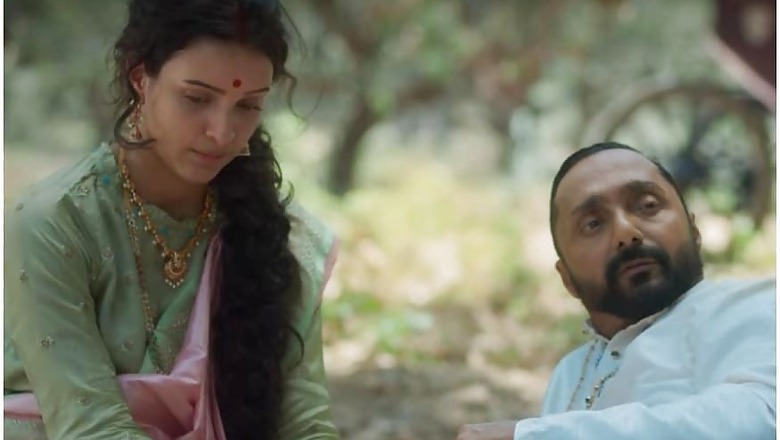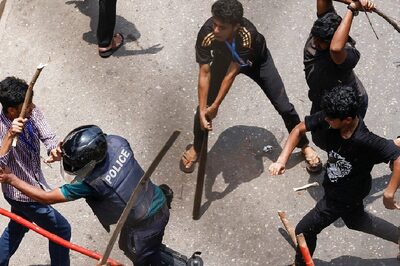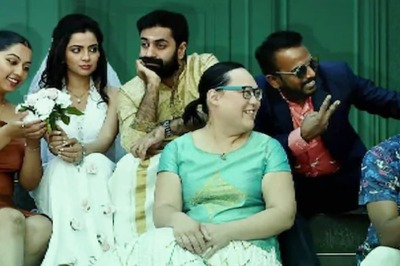
views
There is only one Thakur-o ka Ghar in West Bengal – Jorasanko’s Thakur Bari – where the Nobel laureate poet, Rabindranath Tagore, was born in 1861. In Netflix’s new offering Bulbbul, debutante director, Anvita Dutt, takes you back to a dark and neo-classical version of that Thakur Bari, as she introduces her audiences to the women in Tagore’s life and his stories, all rolled into one character -- Bulbbul.
However, make no mistake. Dutt’s film is not another retelling of Tagore’s old tales, nor is it an addition to the list of films based on the poet’s life, but the similarities and influences of Tagore’s love life on Dutt’s script is hard to miss.
To begin with, at the heart of the film is the story of a child bride, Bulbbul (Tripti Dimri), who finds compassion and camaraderie with her brother-in-law, Satya (Avinash Tiwary) because he is much closer to her own age than her new husband, Bade Thakur (Rahul Bose) who seems to be at least a couple of decades older.
Bulbbul and Satya soon become close, sharing ghost stories, and writing them together, they grow up into their teen years and all is well until Bade Thakur suspects that there is a romantic relationship brewing between the two. He quickly sends Satya off to London for further studies, so that they can be separated.
Anyone who has ever read Rabindranath Tagore and his sister-in-law Kadambari Devi’s love story will tell you that the resemblance between Bulbbul and Kadambari’s stories are uncanny.
Read: Bulbbul Movie Review-A Storm Is Brewing Inside A Sinister Mansion
Much like Kadambari Devi, Bulbbul too is from a poor family and is married into the Takur household really young. In the case of Kadambari Devi, she became Jyotirindranath Tagore’s (Rabindranath Tagore’s elder brother) bride at the age of 9, and was often treated as an outcast, because of her humble origins. During those days, Rabindranath Tagore became Kadambari’s playmate and friend, and as they grew, their relationship turned romantic.
In Bulbbul, we see Satya and Bulbbul discussing that they would transform a wing of their haveli into a writer’s retreat, and paint it blue, but that never really happens because Satya is sent off to London which leaves Bulbbul in agonizing pain and misery. However, in Kadambari Devi’s life, she did transform the terrace of Thakur Bari (the residence of the Tagores) into a rooftop garden – Nandan Kanon -- where literary milieus and salons were held frequently, during which Tagore recited his poems in the presence of literary stalwarts of Bengal. Kadambari Devi not only organized these gatherings but also participated in them freely, which wasn’t a norm back in the day as a woman’s participation in such events were frowned upon.
Much like Satya, Rabindranath Tagore too was sent off to England because of his closeness with Kadambari Devi, which left her devastated. It was, however, Tagore’s father Debendranath Tagore, who took the decision of sending him away, not his brother Jyotirindranath Tagore.
However, Bade Thakur of Bulbbul, played with a pitch-perfect intensity by Rahul Bose did have some similarities with Jyotirindranath Tagore, in the sense that both these men have a relationship with their sister-in-law. But, while Bade Thakur is shown as the egotistical and chauvinistic wife-beater, Jyotirindranath Tagore is said to be no such thing. He was extremely liberal and encouraged Kadambari to learn music, and literature as well as horse riding, and despite the buzzing rumors of the relationship of Kadambari and Rabindranath Tagore, he never explicitly questioned her about it. Instead, it is often said that at the time he was involved in a clandestine affair with a beautiful theatre actress, Nati Binodini.
Unsurprisingly, Paoli Dam, who plays the role of Bade Thakur’s sister-in-law in Bulbbul is also called Binodini in the film. Binodini eventually loses her husband Mahendra (the twin brother of Bade Thakur), and becomes a widow, like another famous Tagore female character by the same name in his story, Chokher Bali, which was played by Aishwarya Rai in Rituparno Ghosh's 2003 film by the same name.
Bulbbul also gives a big nod to Noshtonirh, the short novella that Tagore wrote, which was later made into a film by Satyajit Ray, titled Charulata. That Novella too, was based on the Rabindranath Tagore-Kadambari’s Devi relationship.
Another strange coincidence, if at all it is a coincidence, is that Tagore had nicknamed his beloved Kadambari, ‘Hecate’ after the Greek Goddess of magic, the moon and the night, and of witchcraft and ghosts, and necromancy. If you watch Bulbbul (which you should), you will see how the churel in the film is a manifestation of all of those things.
Tagore’s sister-in-law, Kadambari Devi had taken her own life, Bulbbul too meets death in some sense, but she transmogrifies into something new and strong after that. All similarities to Tagore tales end here, as Dutt’s imagination takes flight under a blood moon, unfolding a fantastical feminist story.
In slightly over a one-and-a-half-hour duration, Bulbbul changes from an opinion less, docile, subservient girl to a strong, confident, and justice delivering Badi Thakurain, who is no longer a victim of circumstances. There is a lot to unpack in this tight film, but the most important thing that it makes obvious by the half time is that the real villain of the film is not the churel, but patriarchy.
The moment Satya returns from Bidesh, he is immediately intimidated by an empowered Bulbbul, who is now the head of the haveli. He quickly assumes, that just because he is the only man in the house, he will automatically overtake her, as the decision-maker. He also disapproves of Bulbbul’s friendship with her doctor (Parambrata Chatterjee), and suspects that they have a romantic relationship, and tells her that he is only willing to overlook her transgressions if she promises to give up such behavior as if it is for him to decide and forgive. All these things point beautifully at the systematic patriarchy, which was as existent in the early 1900s as it is now.
Satya is also convinced that there isn’t any churel, but all the killings are the work of a man. When he says so to Bulbbul, she playfully retorts, “Koi aurat bhi toh ho sakti hai’, but he doesn’t even register it, because how can a woman (who according to him are of very delicate sensibilities) commit such gory crimes?
The 'chudail' in this film is a concoction of many Indian folklores on demon women, with feet turned backward, and Dakini like fangs. But she is also a kind soul in a beautiful woman’s body who believes in justice and doesn't tolerate discrimination or violence against women. That is why Bulbbul is not a horror film, it is a feminist fairy tale.




















Comments
0 comment